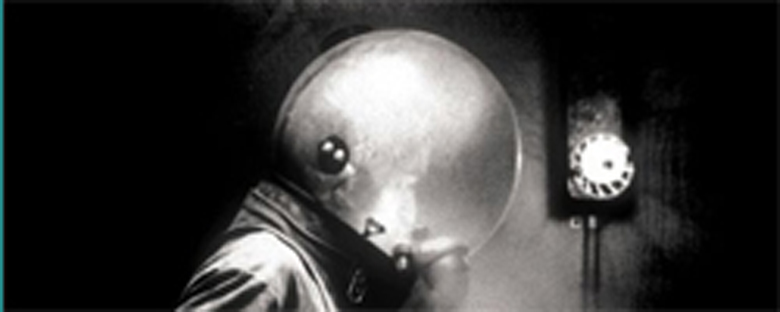Reviews
Cory McAbee
USA, 2001
Credits
Review by Adam Balz
Posted on 19 January 2006
Source Commodore Films DVD
“Why not a space flower?” asks Nancy Bellicec in Philip Kaufman’s Invasion of the Body Snatchers. “Why do we always expect metal ships?” A sardonic observation of the Cold War era, when America’s idea of space involved pie-tins floating down from the cosmos and dart-like rockets soaring up: perceptions typified by the idealistic pulp-magazine paintings of Chesley Bonestell. It was a notion that sci-fi author Ursula K. Le Guin banished to “a nice safe hideyhole” in an essay the same year of Kaufman’s remake. Twenty-three years later, director Cory McAbee went a step further, trading in the idealistic rockets and ray-guns of Buck Rogers for a space-faring RV and dancing barflies. His vision of the future is, to say the least, skewed and unromantic—a shindig to Kubrick’s slow, operatic ballet of the late 1960s. And, as Captain Samuel Curtis, McAbee experiences every distorted corner.
The American Astronaut begins as Captain Curtis lands his ship on Ceres, an asteroid, and enters a disgusting tavern. There he meets the Blueberry Pirate, an old friend and interstellar fruit trader who gives Curtis a new assignment: the only man on Venus has died, and his replacement lives on Jupiter, an all-male mining planet, and goes by the name The Boy Who Actually Saw a Woman’s Breast. It’s Curtis’ responsibility to retrieve the Boy and escort him to Venus, where he’ll be used for reproduction until, someday, he dies and needs replacing.
Out to stop Curtis is the ungainly Professor Hess, played dutifully by bowtied Rocco Sisto. We learn in the beginning that The American Astronaut is his story, of how he became a father. Only later do we discover that his child, a boy, is the offspring of long-lost silver-miners; another child, a fluid-like daughter in a suitcase, also makes rare appearances. For much of the movie Hess follows Curtis, intent on finding, forgiving, and killing him, adhering to his philosophy of murdering only those he has no ill will towards. It’s Professor Hess who infuses the movie with its most beautifully anomalistic moments, especially as he disintegrates tens of hundreds of men and dances in their remnants. Consider the following exchange between Hess and Curtis halfway through the film:
Professor Hess (on the phone): Guess who this is.
Captain Curtis: Professor Hess.
Professor Hess: That’s right! You got it on the first try! For that you get a kiss!
Captain Curtis: I’ll pass.
Professor Hess: What? You think I’d kiss you? You’d love it if I’d kiss you. And I would never kiss you!
Captain Curtis: You said you were going to kiss me.
Professor Hess: I never said I’d kiss you. I never said that. You just want me to kiss you!
Captain Curtis: Um… not really.
Professor Hess: Oh. I’m not good enough to kiss you, is that what you’re saying?
But the most remarkable scene occurs in a floating barn, where Curtis and the Boy decide to take refuge. Inside, the two encounter the leader of that long-forgotten race of traveling silver-miners. Hidden in the darkness of space, we can barely see his decalcified body, thin and brittle from atrophy and bobbing like a worn-down marionette puppet on rickety strings.
The American Astronaut is an experiment in genre-bending. It’s a western without any high-noon shootouts, a sci-fi work of art with musical numbers, a drama with exaggerated characters. Transitions are accomplished using dark, empty paintings inspired by Orson Welles, and shadows become much of the viewer’s focus. And, on top of the black-and-white photography and subdued sets, it’s helped along by an agreeably nontraditional soundtrack by the Billy Nayer Show, a cult band of which Cory McAbee is a member. Songs like “Bodysuit” and “The Girl with the Vagina Made of Glass” are the antithesis of Rogers and Hammerstein, but rather than acting as brazen displays of emotion, they’re moments of actual dialogue.
The only true downside is the ending, which comes off as almost a copout. Though the film’s scientific unfeasibility is both genuine and perfectly well-suited, the final few minutes on Venus are disillusioning. A planet famed for being bathed in the heat of the sun is, in fact, more reminiscent of the backwoods of Wisconsin. In his “live” commentary, director McAbee explains that “This scene is a huge change in dynamics… This is the first time you see sunshine, and it’s the first time you see girls, or women… And the idea behind that was to have a new feeling in the film. Again, it’s not in keeping with regular dynamics of a Hollywood film, but I think it’s lovely and refreshing.” Truly, because McAbee and his crew are such professionals at using innovating objects and subjects, the last scene’s shortcomings are paled by the astonishing final product.
We don’t do comments anymore, but you may contact us here or find us on Twitter or Facebook.



